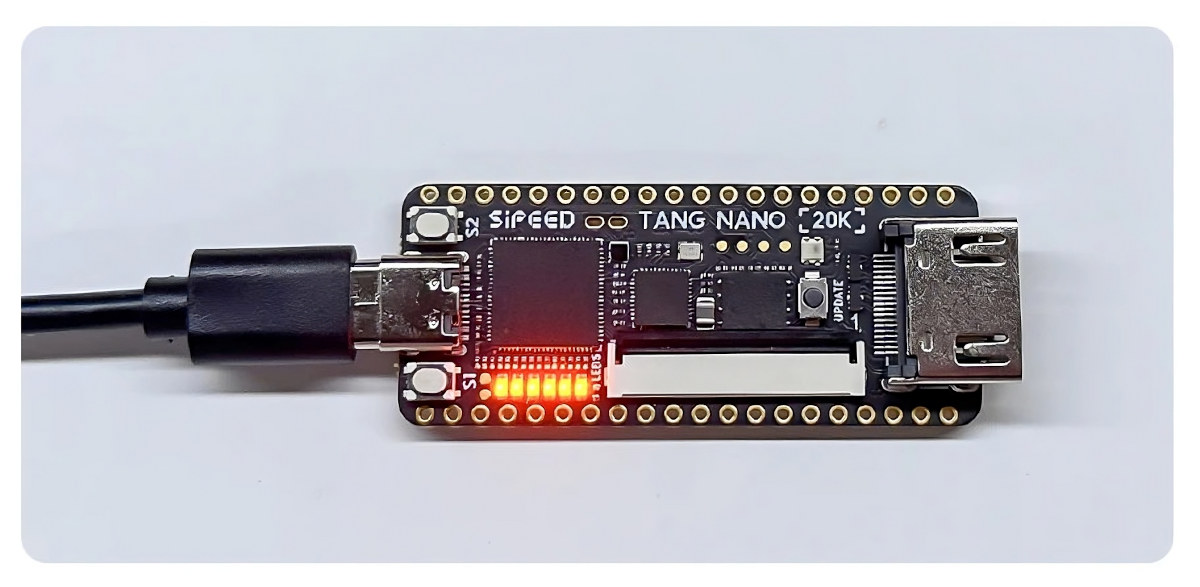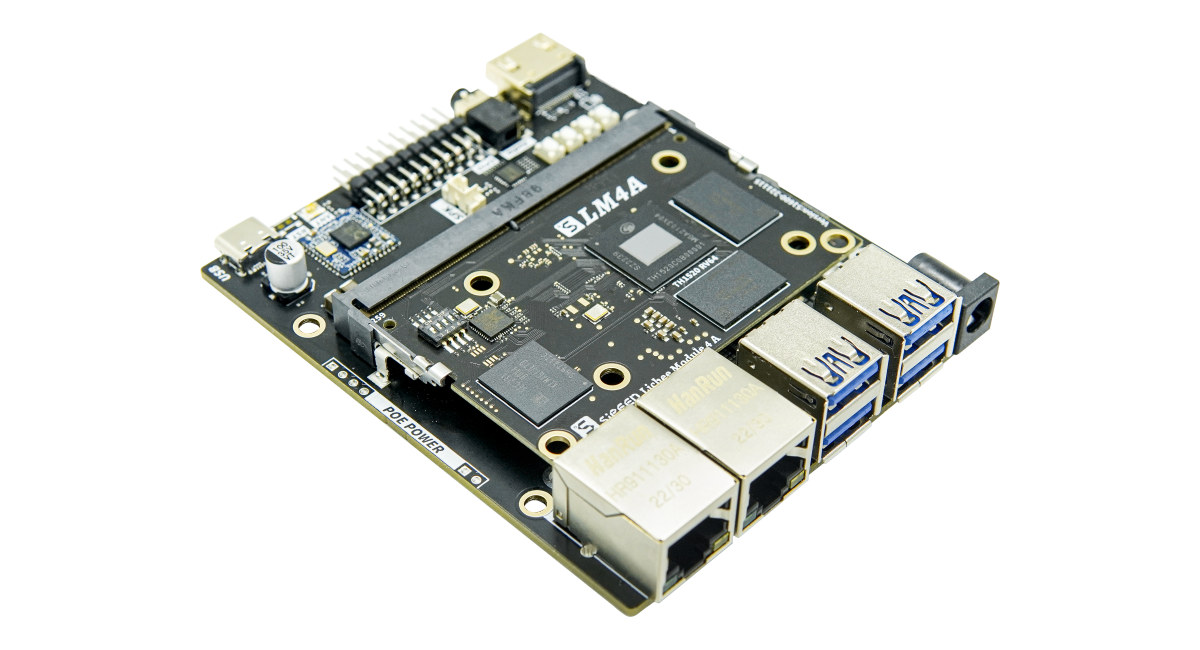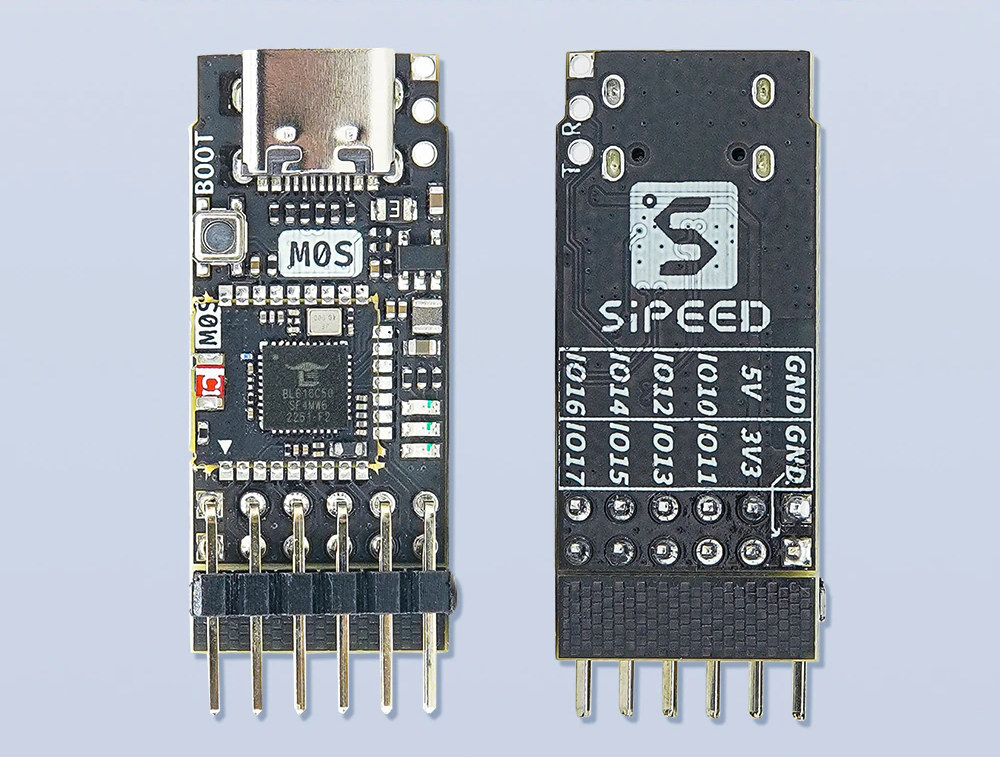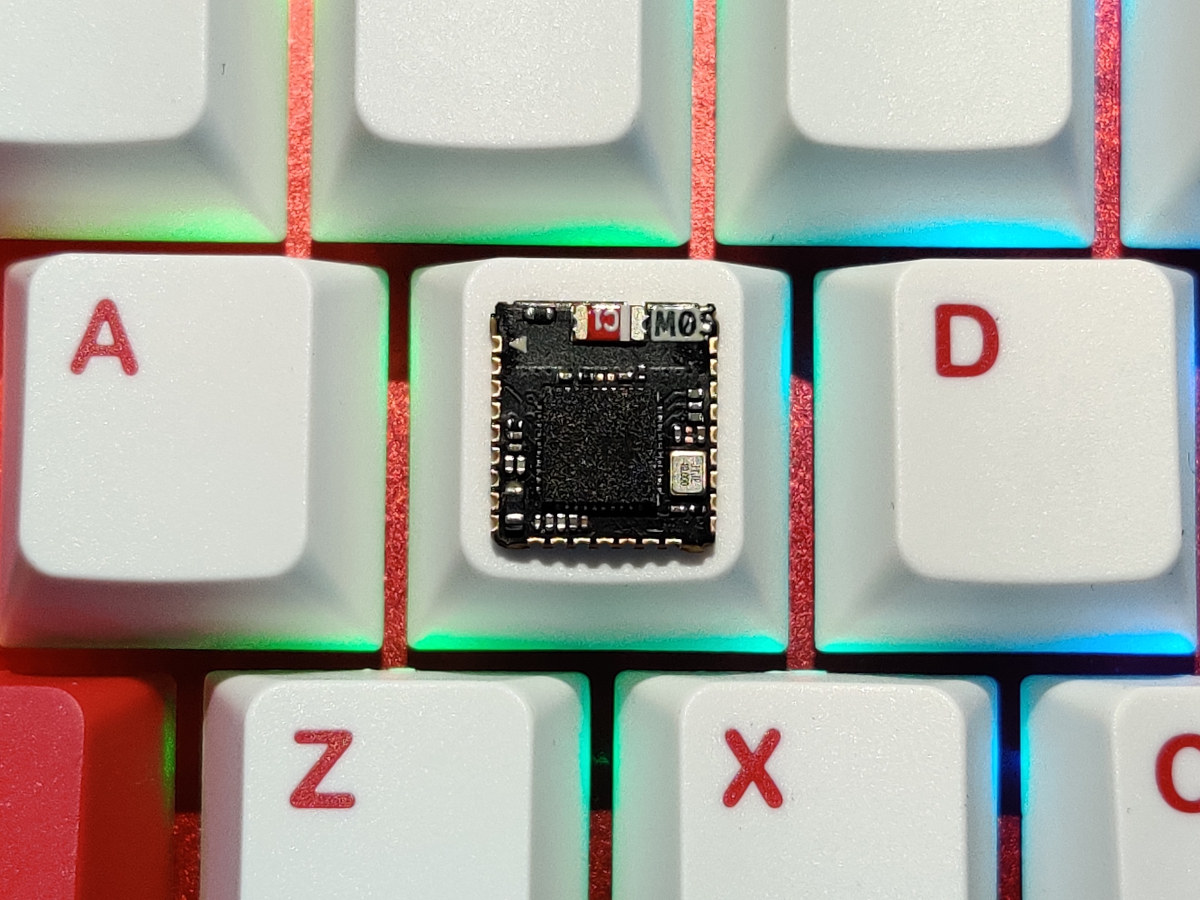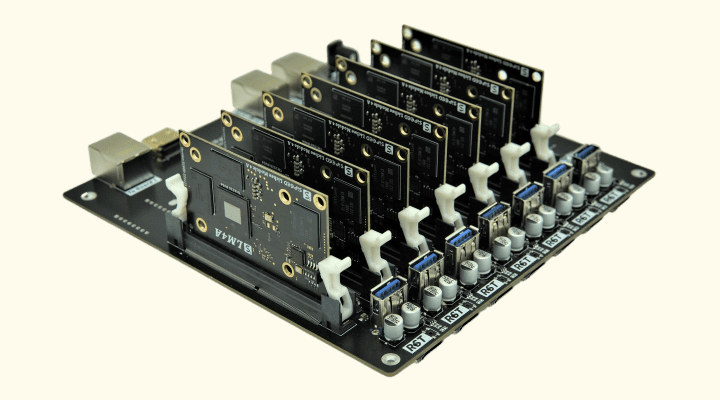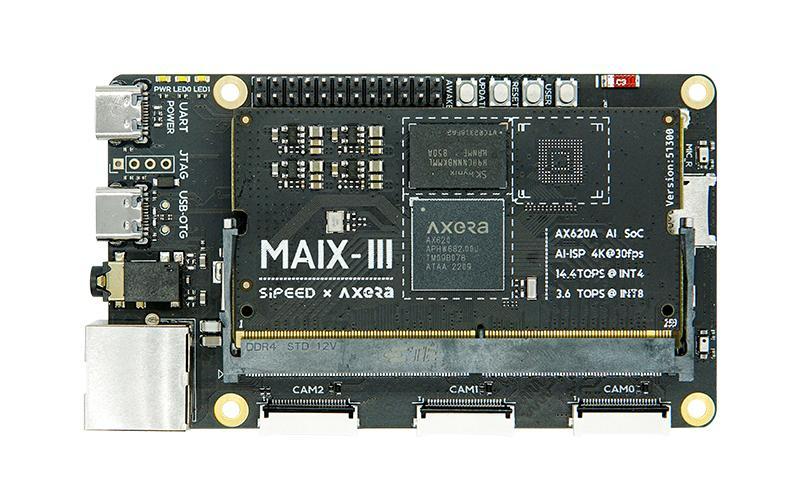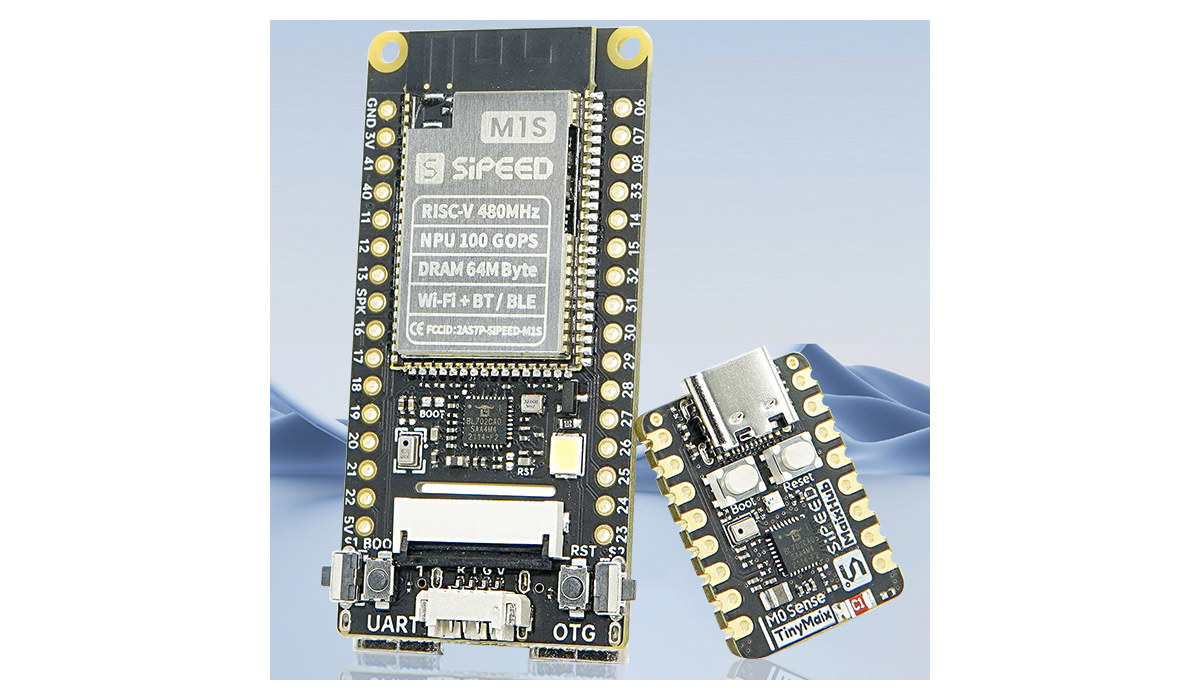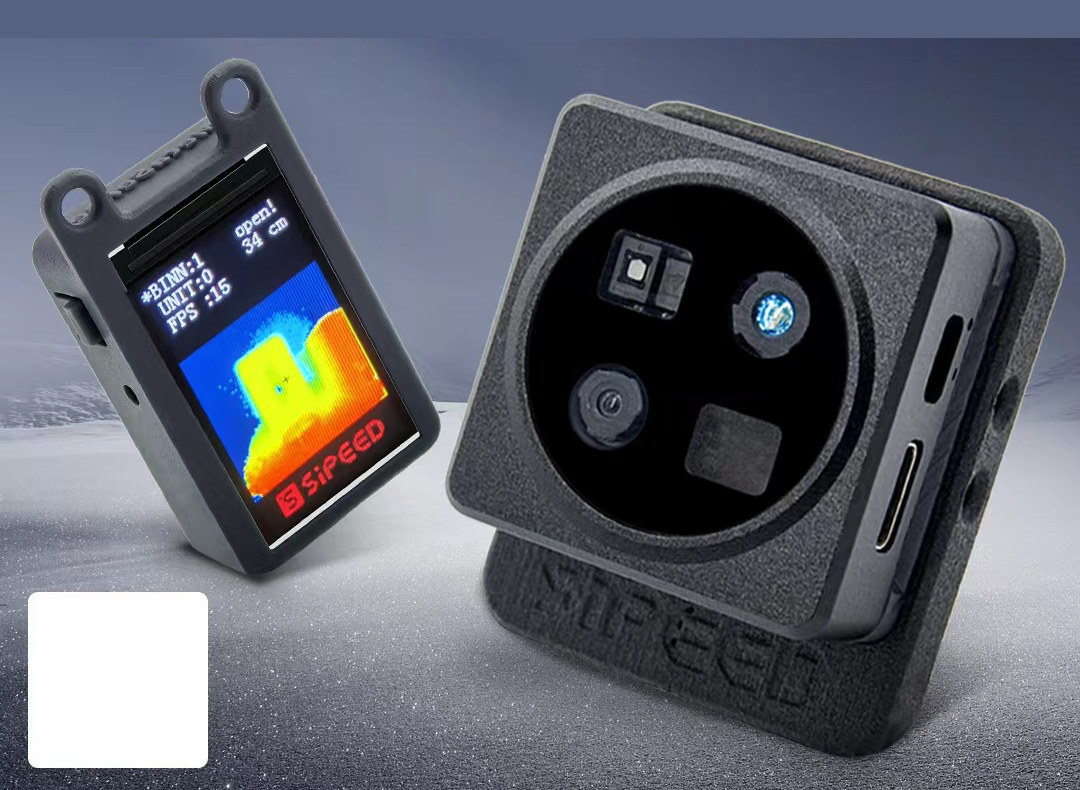The Sipeed Tang Nano 20K is a low-cost FPGA development board based on Gowin GW2AR-18 FPGA with 20,736 logic cells and 64Mbit RAM, which coupled with 64MBit QSPI flash provides enough resources to simulate a 32-bit RISC-V core booting Linux or playing retro games in an emulator. The FPGA board comes with a USB-C port for power and to load the FPGA bitstream through a BL616 microcontroller that also acts as a USB to serial chip, an HDMI port and an RGB LCD interface for video output, two user buttons, and two rows GPIOs to connect peripherals such as gamepads (through adapters). Sipeed Tang Nano 20K specifications: FPGA – Gowin GW2A-LV18QN88C8I7 with 20,736 logic units (LUT4) 15,552 flip-flops (FF) RAM 41,472 shadow SRAM (S-SRAM) 828K block SRAM (B-SRAM) Numbers of B-SRAM – 46 64Mbit 32-bit SDR SDRAM 48x 18×18 multipliers 2x PLLs 8x I/O Bank Onboard debugger – Bouffalo Labs […]
Lichee Pi 4A RISC-V SBC takes on Raspberry Pi 4 with TH1520 processor
Lichee Pi 4A is a single board computer (SBC) powered by Alibaba T-Head TH1520 quad-core RISC-V Xuantie C910 processor @ 2.0 GHz with an Imagination GPU and a 4 TOPS NPU for AI that can compete against the Raspberry Pi 4 in terms of performance and features. We previously mentioned the Lichee Pi 4A (LPi4A) in our article about the Sipeed LM4A RISC-V system-on-module, but at the time we only had some benchmarks for the board and no photos and specifications about the SBC. Sipeed has now released photos, published detailed specifications, and is taking orders for the board. So let’s have a closer look. Lichee Pi 4A specifications against the ones for Raspberry Pi 4. The TH1520 used to be advertised at up to 2.5 GHz, but it seems to have now come down to 2.0 GHz. Software support will include Debian, OpenWrt, and Android which should then […]
$4 Sipeed M0S Dock IoT development board features BL616 WiFi 6, BLE 5.2, and Zigbee RISC-V microcontroller
As expected, Sipeed has now launched the Sipeed M0S IoT module based on Bouffalo Lab BL616 RISC-V microcontroller with 2.4 GHz WiFi 6, BLE 5.2, and Zigbee connectivity along with the “Sipeed M0S Dock” development board. The M0S is a tiny module (11×10 mm) with a 320 MHz wireless MCU, a ceramic antenna, and castellated holes for I/Os, and the Sipeed M0S Dock places the module on an easy-to-use board with a USB Type-C port, a BOOT button, and a 12-pin 2.54mm pitch header. Sipeed M0S module specifications: MCU – Bouffalo Lab BL616 32-bit RISC-V (RV32IMAFCP) microcontroller @ up to 320 MHz (384 MHz overclocked) with 480KB SRAM, 4MB flash, 2.4 GHz WiFi 6, Bluetooth 5.2 dual mode, and 802.15.4 radio (Zigbee) Antenna – Ceramic antenna (red component on module) I/Os – 25 castellated holes with RGB LCD DVP camera USB 2.0 OTG up to 480 Mbps I2C, UART, SPI […]
Bouffalo Lab BL616/BL618 RISC-V MCU supports WiFi 6, Bluetooth 5.2, and Zigbee
Bouffalo Lab BL616/BL618 is a 32-bit RISC-V wireless microcontroller with support for 2.4 GHz WiFi 6, Bluetooth 5.2 dual-mode, and an 802.15.4 radio for Zigbee, Thread, and Matter designed for IoT applications. We first spotted the BL616 RISC-V IoT MCU during the BL602/BL606 announcement in November 2020, but we had virtually no additional information about it so far. It appears both BL616 and BL618 will be launched next month with the main difference between the two being that BL616 has 19 GPIOs and BL618 comes with 35 GPIOs. Bouffalo Lab BL616 and BL618 specifications: MCU core – 32-bit RISC-V CPU (RV32IMAFCP) @ up to 320 MHz with FPU and DSP, 32KB instruction cache & 16KB data cache VPU – MJPEG video encoder Memory – 480KB SRAM, 4KB HBN RAM, embedded 4 or 8MB pSRAM (optional) Storage – 128KB ROM, 4Kb eFuse, embedded 2, 4, or 8MB flash (optional), XIP QSPI […]
Sipeed LM4A – T-Head TH1520 RISC-V module to power Raspberry Pi 4 competitor and cluster board
Sipeed LM4A is a quad-core RISC-V system-on-module based on the T-Head TH1520 SoC found in the ROMA laptop and destinated to be found in a Raspberry Pi SBC competitor as well as a cluster board. The LM4A, which stands for Lichee Module 4 Model A, comes with 4GB to 16GB RAM, and up to 64GB flash, and connects to the carrier board through a 260-pin SO-DIMM connector. The TH1520 is one of the rare RISC-V SoCs with a 3D GPU, and the SBC based on LM4A has been shown to outperform the Raspberry Pi 4 in benchmarks as we’ll see below. Sipeed LM4A specifications: SoC – Alibaba T-Head TH1520 quad-core RISC-V Xuantie C910 (RV64GCV) processor @ 2.5 GHz, Xuantie C906 audio DSP @ 800 MHz, low power Xuantie E902 core, 50 GFLOPS Imagination 3D GPU, and 4 TOPS NPU System Memory – 4GB, 8GB, or 16GB RAM Storage – Optional […]
Sipeed Maix-III devkit features AXERA AX620A SoC for AI vision applications
Sipeed Maix-III development kit is composed of a core board equipped with AXERA AX620A AI processor and a carrier board exposing several interfaces such as Ethernet, USB, and camera connectors. resources. As noted in our earlier article about the AXERA AX620A chip, it is a quad-core Arm Cortex-A7 chip with an NPU offering a maximum of 14.4 TOPS @ INT4 or 3.6TOPSs @ INT8, and as such, this development board mainly targets AI vision applications. The board is an upgrade to the earlier Speed Maix II with an Allwinner V831 processor. Thanks to the low power consumption of the AXERA AX620A SoC, the Sipeed Maix-III board can be powered directly through its USB port as the system consumers 5W (5V@1A) with the carrier board, the system-on-module, WiFi, Ethernet, a camera, and a 5-inch display. Using the display does not require am additional heatsink or fan, nor does it require an […]
Sipeed M1s & M0sense – Low-cost BL808 & BL702 based AI modules (Crowdfunding)
Sipeed has launched the M1s and M0Sense AI modules. Designed for AIoT application, the Sipeed M1s is based on the Bouffalo Lab BL808 32-bit/64-bit RISC-V wireless SoC with WiFi, Bluetooth, and an 802.15.4 radio for Zigbee support, as well as the BLAI-100 (Bouffalo Lab AI engine) NPU for video/audio detection and/or recognition. The Sipeed M0Sense targets TinyML applications with the Bouffa Lab BL702 32-bit microcontroller also offering WiFi, BLE, and Zigbee connectivity. Sipeed M1s AIoT module The Sipeed M1S is an update to the Kendryte K210-powered Sipeed M1 introduced several years ago. Sipeed M1s module specifications: SoC – Bouffalo Lab BL808 with CPU Alibaba T-head C906 64-bit RISC-V (RV64GCV+) core @ 480MHz Alibaba T-head E907 32-bit RISC-V (RV32GCP+) core @ 320MHz 32-bit RISC-V (RV32EMC) core @ 160 MHz Memory – 768KB SRAM and 64MB embedded PSRAM AI accelerator – NPU BLAI-100 (Bouffalo Lab AI engine) for video/audio detection/recognition delivering up […]
Sipeed MetaSense RGB ToF 3D depth cameras are made for MCUs & ROS Robots (Crowfunding)
We’ve just written about the Arducam ToF camera to add depth sensing to Raspberry Pi, but there are now more choices, as Sipeed has just introduced its MetaSense ToF (Time-of-Flight) camera family for microcontrollers and robots running ROS with two models offering different sets of features and capabilities. The MetaSense A075V USB camera offers 320×240 depth resolution plus an extra RGB sensor, an IMU unit, and a CPU with built-in NPU that makes it ideal for ROS 1/2 robots, while the lower-end MetaSense A010 ToF camera offers up to 100×100 resolution, integrates a 1.14-inch LCD display to visualize depth data in real-time and can be connected to a microcontroller host, or even a Raspberry Pi, through UART or USB. MetaSense A075V specifications: SoC – Unnamed quad-core Arm Cortex-A7 processor @ 1.5 GHz with 0.4 TOPS NPU System Memory – 128 MB RAM Storage – 128MB flash Cameras 800×600 @ 30 […]


